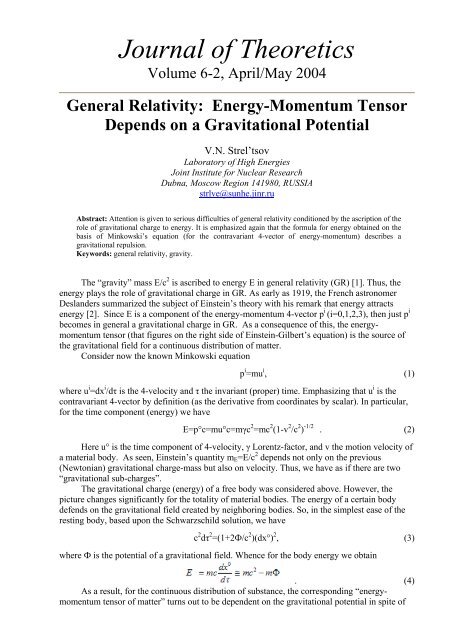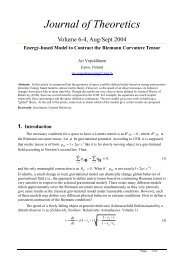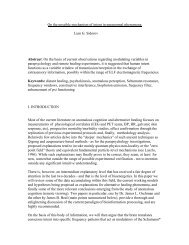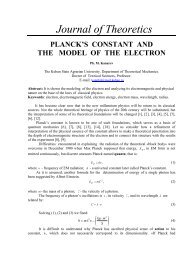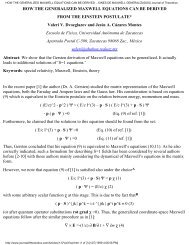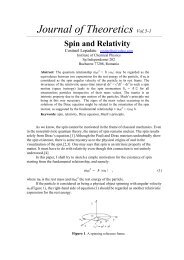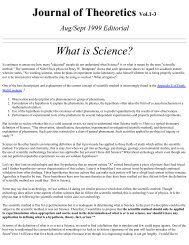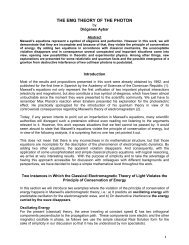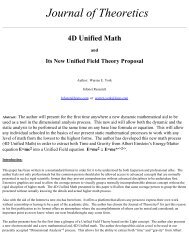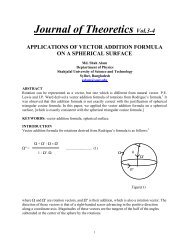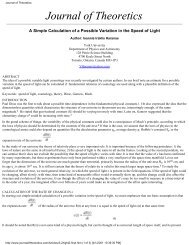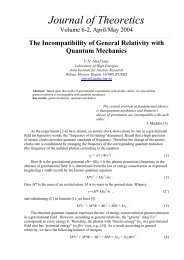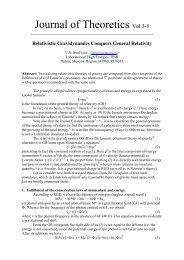Energy-Momentum Tensor Depends on a Gravitational Potential
Energy-Momentum Tensor Depends on a Gravitational Potential
Energy-Momentum Tensor Depends on a Gravitational Potential
You also want an ePaper? Increase the reach of your titles
YUMPU automatically turns print PDFs into web optimized ePapers that Google loves.
Journal of Theoretics<br />
Volume 6-2, April/May 2004<br />
General Relativity: <str<strong>on</strong>g>Energy</str<strong>on</strong>g>-<str<strong>on</strong>g>Momentum</str<strong>on</strong>g> <str<strong>on</strong>g>Tensor</str<strong>on</strong>g><br />
<str<strong>on</strong>g>Depends</str<strong>on</strong>g> <strong>on</strong> a Gravitati<strong>on</strong>al <strong>Potential</strong><br />
V.N. Strel’tsov<br />
Laboratory of High Energies<br />
Joint Institute for Nuclear Research<br />
Dubna, Moscow Regi<strong>on</strong> 141980, RUSSIA<br />
strlve@sunhe.jinr.ru<br />
Abstract: Attenti<strong>on</strong> is given to serious difficulties of general relativity c<strong>on</strong>diti<strong>on</strong>ed by the ascripti<strong>on</strong> of the<br />
role of gravitati<strong>on</strong>al charge to energy. It is emphasized again that the formula for energy obtained <strong>on</strong> the<br />
basis of Minkowski’s equati<strong>on</strong> (for the c<strong>on</strong>travariant 4-vector of energy-momentum) describes a<br />
gravitati<strong>on</strong>al repulsi<strong>on</strong>.<br />
Keywords: general relativity, gravity.<br />
The “gravity” mass E/c 2 is ascribed to energy E in general relativity (GR) [1]. Thus, the<br />
energy plays the role of gravitati<strong>on</strong>al charge in GR. As early as 1919, the French astr<strong>on</strong>omer<br />
Deslanders summarized the subject of Einstein’s theory with his remark that energy attracts<br />
energy [2]. Since E is a comp<strong>on</strong>ent of the energy-momentum 4-vector p i (i=0,1,2,3), then just p i<br />
becomes in general a gravitati<strong>on</strong>al charge in GR. As a c<strong>on</strong>sequence of this, the energymomentum<br />
tensor (that figures <strong>on</strong> the right side of Einstein-Gilbert’s equati<strong>on</strong>) is the source of<br />
the gravitati<strong>on</strong>al field for a c<strong>on</strong>tinuous distributi<strong>on</strong> of matter.<br />
C<strong>on</strong>sider now the known Minkowski equati<strong>on</strong><br />
p i =mu i , (1)<br />
where u i =dx i /dτ is the 4-velocity and τ the invariant (proper) time. Emphasizing that u i is the<br />
c<strong>on</strong>travariant 4-vector by definiti<strong>on</strong> (as the derivative from coordinates by scalar). In particular,<br />
for the time comp<strong>on</strong>ent (energy) we have<br />
E=p°c=mu°c=mγc 2 =mc 2 (1-v 2 /c 2 ) -1/2 . (2)<br />
Here u° is the time comp<strong>on</strong>ent of 4-velocity, γ Lorentz-factor, and v the moti<strong>on</strong> velocity of<br />
a material body. As seen, Einstein’s quantity m E =E/c 2 depends not <strong>on</strong>ly <strong>on</strong> the previous<br />
(Newt<strong>on</strong>ian) gravitati<strong>on</strong>al charge-mass but also <strong>on</strong> velocity. Thus, we have as if there are two<br />
“gravitati<strong>on</strong>al sub-charges”.<br />
The gravitati<strong>on</strong>al charge (energy) of a free body was c<strong>on</strong>sidered above. However, the<br />
picture changes significantly for the totality of material bodies. The energy of a certain body<br />
defends <strong>on</strong> the gravitati<strong>on</strong>al field created by neighboring bodies. So, in the simplest ease of the<br />
resting body, based up<strong>on</strong> the Schwarzschild soluti<strong>on</strong>, we have<br />
c 2 dτ 2 =(1+2Ф/c 2 )(dx°) 2 , (3)<br />
where Ф is the potential of a gravitati<strong>on</strong>al field. Whence for the body energy we obtain<br />
. (4)<br />
As a result, for the c<strong>on</strong>tinuous distributi<strong>on</strong> of substance, the corresp<strong>on</strong>ding “energymomentum<br />
tensor of matter” turns out to be dependent <strong>on</strong> the gravitati<strong>on</strong>al potential in spite of
its name. On the other hand, the negative sign of the sec<strong>on</strong>d term of expressi<strong>on</strong> (4) means that<br />
the c<strong>on</strong>travariant form of energy in GR describes gravitati<strong>on</strong>al repulsi<strong>on</strong> [3]. Thus, if the particle<br />
as a de Broglie wave (described by the covariant 4-vector of energy-momentum p i ) is attracted<br />
by a gravitati<strong>on</strong>al field, then it as a particle (described by the c<strong>on</strong>travariant 4-vector p i ) tries a<br />
gravitati<strong>on</strong>al repulsi<strong>on</strong>. The ascripti<strong>on</strong> of the role of gravitati<strong>on</strong>al charge to energy led to such<br />
strange c<strong>on</strong>sequence.<br />
C<strong>on</strong>clusi<strong>on</strong><br />
<str<strong>on</strong>g>Energy</str<strong>on</strong>g> takes <strong>on</strong>, in GR, the role of gravitati<strong>on</strong>al charge that depends <strong>on</strong> two sub-charges:<br />
mass and velocity. What is more, the energy-momentum tensor of matter also depends <strong>on</strong> the<br />
gravitati<strong>on</strong>al potential.<br />
References<br />
[1] Einstein A., Jahrb.Radioakt.Elect. 4, 411(1907).<br />
[2] Pais A., “Subtl is the Lord…”. The Science and the Life of Albert Einstein, p.308 (Oxford<br />
Univ.Press, N.Y., 1982).<br />
[3] Strel’tsov V.N., Apeir<strong>on</strong> 6, 245 (1999); J. of Theoretics 4, No.3 (2002).<br />
Received March 2003<br />
Journal Home Page<br />
© Journal of Theoretics, Inc. 2004


